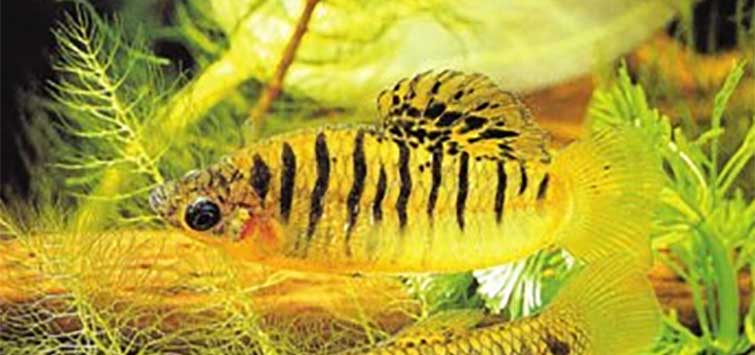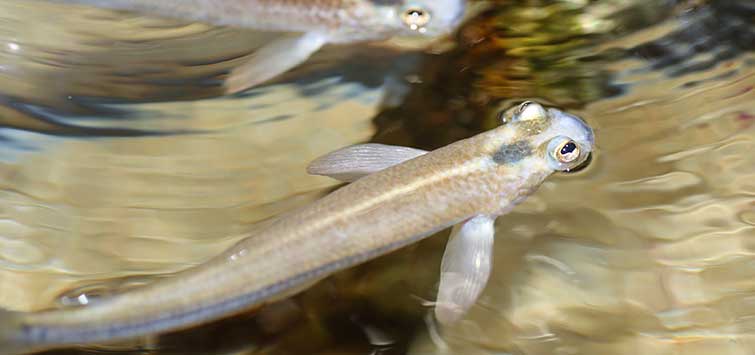Livebearers Unlimited: The Caribbean Jewels
Author: Ted Coletti, PhD
It was autumn, 1998. Standing at the back of the dark hall of the American Legion in Nutley, New Jersey, I wondered when the auctioneer would offer something to wake me up. For months it had been the same old species (nearly all cichlids), making the rounds among the members. This night’s pickings were going cheap.
Then came the call from the auctioneer: “Lot number 35. Endangered livebearer here…Limia sulphuro-something-or-other. Who gives me a buck?”
I had been playing with a few wild-type livebearers for the past couple of years and found the change a welcome one. But even this aquatic bookworm had never heard of this species before. I was ready to enter into combat if a bidding war erupted—which, of course, it did.
Five minutes later (and $20 poorer) I was the proud owner of eight juvenile livebearers that I knew absolutely nothing about. As I walked out of the hall, the seller of the lot approached me.
“Be patient and watch what happens,” he said.
Among specialists, there is always one species we can pinpoint as the catalyst for our deep dive into a fish family. For me, it was that $20 bag of Limia sulphurophila.
What is a Limia?
Fishes in the genus Limia are members of the family Poeciliidae, which includes the popular mollies and guppies (Poecilia), platies and swordtails (Xiphophorus), and about 150-plus additional livebearing species. Limia makes up about 10 percent of poeciliids, currently comprising at least 21 species. Some species are very similar and open to debate, and several new populations probably have yet to be discovered. So the final Limia species count is in question until the taxonomic smoke clears.
Geographic Range
All limiashail from the islands of the Caribbean, specifically the Caymans, Cuba, Jamaica, and the island of Hispaniola (Dominican Republic and Haiti). At first it was thought that limias were closely related to mollies as a sister genus, but recent DNA sequencing data indicates this is not the case. Evolutionary theories range from a marine migration from the Central/South American land mass, to isolation of a poeciliid population when some of the Great Antilles broke off from the mainland. Some scientists have proposed limiasto be ancestral poeciliids. The need for more extensive collections, DNA analyses, and fossil records continues.
Naming
Limia means “muddy” in Latin, a reference to the Havana, Cuba biotope of the type species, L. vittata. The genus was established in 1854 by Poey, then later transferred as a Poecilia subgenus by Rosen and Bailey in their seminal 1963 work. This caused some practical problems, as there were now Poecilia with the same species names! Almost immediately Rivas and other scientists continued to recognize Limia, however. It was resurrected as its own genus by Rivas in 1978 and 1980, with eight new species. Rivas died in 1986 before he could finish his re-classification of Limia. In recent years, the “tiger limia” from Lake Miragoane, Haiti has made its rounds in the hobby, awaiting species status.
Characteristics
Limias range in size from 1 to 3 inches, so they are very suitable for the aquarium. They share a characteristic dorsal spot, at least in their juvenile stage. Haitian species are often characterized by striping on the bodies, and Hispaniolan species often have some color in the dorsals. Many have shimmering scales and contrasting body colors in the flanks versus the finnage. I have found that the colors of limias tend to get better with age, so hobbyists need to be patient, as the original seller of my lot of L. sulphurophila had told me to be.
Spawning
Nearly all limias mate via “sneak copulation,” which is where males come from underneath and behind without any courtship display to entice a female. In fishdom, this type of behavior generally results in less elaborate size, color, and finnage in males. But three species (and perhaps the tiger limia) do court their females, serving up interesting behavioral displays for the hobbyist. They are the closely related L. perugiae and L. nigrofasciata (“humpbacked limia”) from Hispaniola, as well as what may be the most ancestral Limia, Jamaica’s L. melanogaster (“black belly limia”). These three species are all truly lovely in terms of their colors, finnage, and unique shapes.
Tank Requirements
Limia tend to enjoy calcium hard or brackish water that is alkaline. Most do just fine in a 10-gallon tank. I like to keep the temperatures a bit on the high side, near 80°F, until I can ascertain the hardiness or domestication of the stock I am working with. All these water variables coincide with the native Caribbean conditions.
So the next time you’re at an auction, and a bag of these Caribbean jewels comes up, don’t be afraid to plunk down some extra coins for these interesting livebearers.
And remember: “Be patient and watch what happens.”
Guppy Corner
Unquestionably one of the most, if not the most, popular show guppy in the new millennium is the strain known as the “full red.” The full red fancy guppy is red throughout its body, from head through large delta tail. It is a fish you will only see in all its glory at an International Fancy Guppy Association (IFGA) guppy show—go to www.ifga.com for locations and schedule.
This was no easy feat of selective breeding. Full color throughout a guppy has been a challenge of guppy breeders ever since there were guppy breeders. In the 1990s the blue-black Moscow guppy made its appearance, from the Russian city where many-a-good fancy tropical fish have originated. This fish showed its color from head through tail. I always thought the full red was essentially a red Moscow, but it appears this may not be the case. Both strains probably developed independently of one another, and indeed the current red Moscow is a cross between these two fish.
Origins
The full red is probably of American origin. One account was by a breeder named David M. Reaume who discovered a sport in his red guppy tanks around 1993 or 1994. He knew it was special as it developed extra red coloring over its body and onto its gill covers. The sport’s immediate ancestors included a fine petshop red guppy male and gold guppy female, and a flamingo half-black from Homestead, Florida’s Summerland Fish Farm. Go figure!
Reaume’s Strategy
Reaume quickly converted his entire 6-tank breeding operation over to developing an all-red guppy. His story is one that all prospective fancy livebearer breeders should read. It is a story of dedication and frustration, with small successes building up over many years, marked by constant setbacks with impurities. It is hobbyists like these, folks, to whom we owe much gratitude.
When Reaume’s full red breeding program began, he was plagued by infertility problems in subsequent generations. The red gene also apparently “skipped” every other generation. When it did express, the red body trait initially only appeared in 10 to 15 percent of offspring. Reaume hypothesized female choice and multiple gene interactions as culprits.
Reaume was also dealing with pesky white tips on the dorsal fins, and hump-backed traits in about 20 percent of his males. Fortunately, he also discovered his developing full reds to be longer lived and slower to mature (and show color) than show guppies. A few years later, all-red females began appearing in the breeding tanks.
Reaume also did something else that is commendable. He shared his new stock with other breeders so the strain would not be lost. Many a great strain of livebearer has vanished into history because of the competitive privacy or lack of interest among breeders. Wood’s lyretail mollies circa 1970 and the red jet swordtails of the late 1950s are just two examples of now-extinct strains.
Charles Pratt, the editor of the IFGA’s Bulletin, reported Reaume’s story, and has observed that the full red still does not reliably produce full delta or non-ragged tails. But with time and dedication, I’m sure this will be solved as well. You can’t keep a guppy breeder down after all!
Finding Full Reds
You probably won’t find full reds in your local pet shop. Your best bet is to join a local guppy club, attend an International Fancy Guppy Association show and auction, or join the IFGA. Members also receive a wonderful online bulletin.
See the full article on TFH Digital http://www.tfhdigital.com/tfh/200711/#pg46

.png?h=595&iar=0&w=2781&hash=5FD5E69473BCC22199FBFA2FB71B6033)



